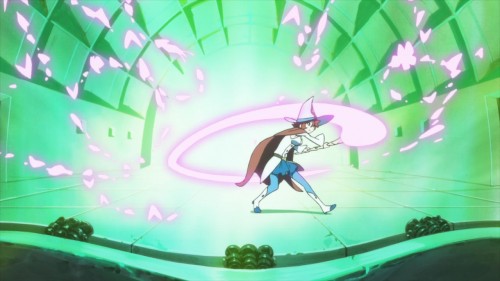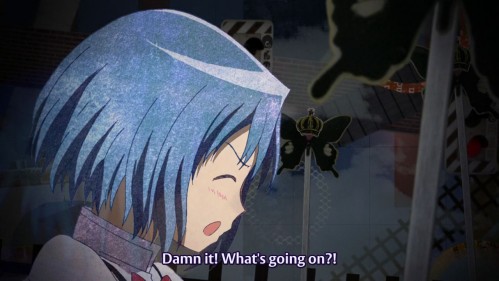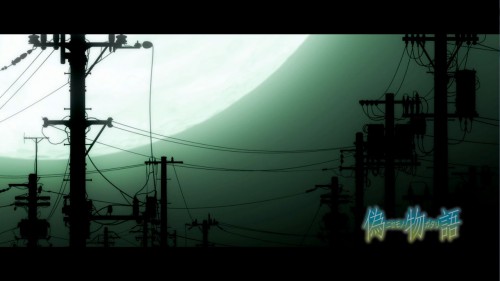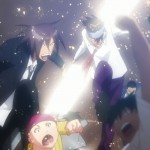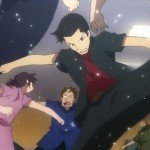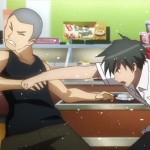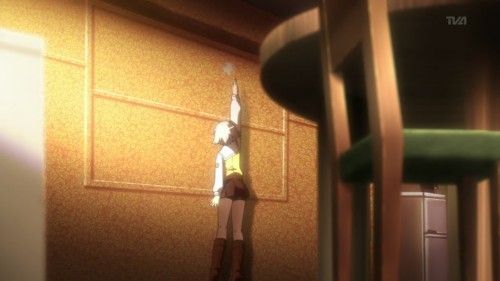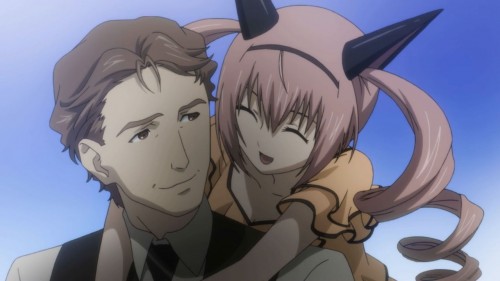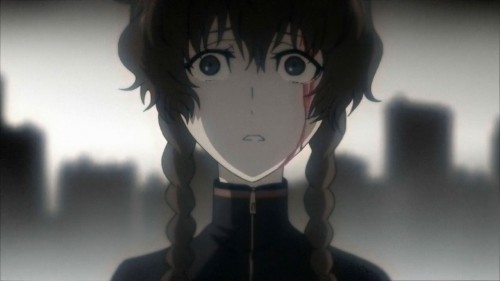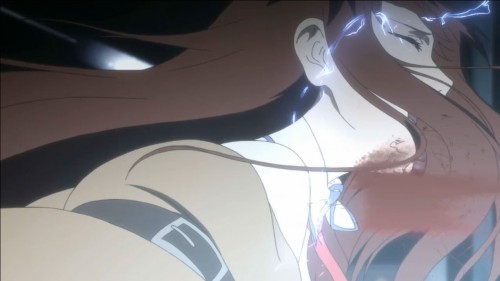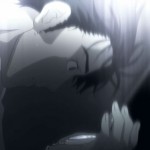Well that was just adorable. Little Witch Academia is a short one-shot anime about a little girl that wants to follow in the footsteps of a performing witch. She gets herself into a prestigious academy for witches, where she she struggles to keep up academically. On top of her problems in class, she learns that the rest of witch culture has a very low opinion of her childhood idol. When a classmate accidentally unleashes a terrible menace from underneath the school, she gets a chance to prove herself and maybe redeem her hero a bit in the process. Good stuff.
Category Archives: Cartoons
Magical Girls, Slowpoke Edition
Back in January of 2011 a show that held just about zero appeal to me aired. It had a dog-choking Japanese name that meant nothing to me, was clearly about a pink-haired magical girl and what looked like a cat with rabbit ears hanging out of its cat ears. Why on Earth would I watch such a thing, I thought. So I didn’t. Turns out I was missing out.
Puella Magi Madoka Magica isn’t your father’s magical girl fare. It’s not a lighthearted tale of some Mary-Sue heroine saving the world repeatedly with the power of love and friendship, though it takes careful pains to look like it is. Here we get the tale of Madoka, a first-year junior high student that is warned by a mysterious stranger not to accept any wishes granted by odd creatures, and definitely not to become a magical girl. What an odd thing to we warned about, as there’s no such thing as wish-granting creatures or magical girls so far as Madoka knows. Enter Kyubey, the aforementioned mutant-cat creature that, predictably, offers her a wish as payment for her becoming a magical girl.
What follows is a gritty, sometimes shocking story of hubris, betrayal, tragedy, loss, personal sacrifice, and perseverance. Clocking in at twelve half-hour episodes and of a unique visual style, I highly recommend giving this title a chance.
Hyouka
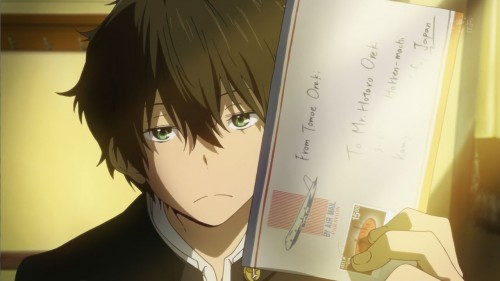
Nondescript high-school boy with a window seat gets his life hijacked by a girl from a high-class family who gets him embroiled in a number of adventures. Sound familiar? It sure does.
Hyouka revolves around a boy named Oreki Houtarou. He’s very average. What distinguishes him from other average-joe main characters in Japanese animation is that he is very intentionally average. He doesn’t like to exert himself or get excited about things, so he only does enough studying to pass his classes, he doesn’t get involved in sports or club activities, and has no discernible hobbies. Rather than pursuing the rose-colored life that every other anime protagonist dreams of, he seeks a calm grey existence. All of this ends when he receives a letter from his pushy older sister, who is up to something-or-other abroad. She insists that he join the Classics Club, of which she had been a member, to prevent it from being discontinued by the school. Figuring it is less effort to fill out a form and be a member of a club with no other members than to put up with his sister, he capitulates.
Lo, he ends up not being the only member. Enter Chitanda Eru, the aforementioned high-class girl. She is Oreki’s opposite in many ways, and quickly finds herself pestering Oreki into actually doing… anything. Eight episodes in, the general plot formula goes something like this: Oreki shows up to class or the Classics Club’s room, one of the ancillary characters brings something up that gets Chitanda’s attention, Chitanda cannot figure out something about whatever it was, and she pressures Oreki into figuring it out for her.
Hyouka has the production values we would expect from Kyoto Animation: very good. The character designs are distinctive without being over-the-top, the animation itself is expressive and thoughtfully done. The hand-held camera work from Episode Eight works quite well; it took a few moments for me to notice how good it was, which is generally a good sign. You don’t want these things to stand out too much, right?
Eight episodes in, and not a dud yet. Highly recommended, go see it.
Nisemonogatari
Somehow I managed to never write anything about a seriously good series that came out a couple years back called Bakemonogatari. It basically revolved around Araragi Koyomi, a high school student that has an overdeveloped sense of justice. Each plot arc involves him coming across a girl that is in the midst of some kind of personal crisis that is manifesting in a supernatural way. The first arc’s victim was a classmate named Senjougahara, who was beautiful and aloof, and had completely lost her weight. By which I don’t mean she was anorexic, but rather that she didn’t weigh anything. With the help of a mysterious occult expert that appears to operate out of an abandoned cram-school, Araragi invariably finds a way to remove or mitigate the girls’ curses and the story moves on to the next incident. Nisemonogatari is the sequel or continuation of Bakemonogatari. Four episodes in we are getting to the meat of the current victim’s plight. Events are conspiring to fill in a bit of the implied back-story from the first season, giving more of an impression that there is truly an over-arcing plot to the story.
The character designs and voice acting are excellent, often provoking conflicting reactions that help keep the presentation of the story off-balance. I found myself sympathizing with characters that on the surface I did not like. The pacing is stylishly disjointed in a manner resembling Sayonara Zetsubo Sensei, with oddly-timed cuts and changes in visual style. Again this helps create a form of dramatic tension that might not otherwise be present. Production quality is quite high, with each plot arc having its own intro sequence in the first series, and each episode changing its intro and ending sequences, a rare expense in popular animation. Sometimes I suspect the production companies do this specifically to appeal to a certain flavor of fanboy that sees such changes as an sure sign of quality, but in this case it’s no ruse.
Highly recommended as of four episodes into the second series.
Pride, Honor, and Half-Priced Food
Twelve episodes sounds like a short run, but Ben-to manages to wrap things up rather nicely in that time frame. Should the producers choose to run off on some endless perpetual status-quo like Dragonball or One Piece or Bleach did, Ben-to has positioned itself nicely, while still providing folks like me with a satisfactory ending. The overall story arc is a simple one, of a young man finding his place in a strange situation. Over the first few episodes we are gradually introduced to a cast of recurring characters, some endearing, some obnoxious, some a little of both. Throughout the process we are steeped in a fictional warrior culture of pride, vengeance, honor, and hunger. We are shown paragons of the way things ought to be, outliers struggling with the norms of discount-food wolves, and several antagonists that epitomize corruptions of the path our protagonist has found himself on.
While the conclusion was satisfactory, I was somewhat disappointed that there was a full-on denouement at all. The outcome of the battle for the grilled eel special wasn’t what mattered. If Ben-to has taught us anything, it is the fight itself that is the most important, of individuals striving in earnest to beat the shit out of each other over supermarket food. Whoever wins it deserves it and will enjoy it; this doesn’t need to be shown.
Not an instant classic, but well worth taking a look.
Ben-to
Faced with the need to obtain lunch and dinner on a modest budget, a brave young man seeks out the discount-priced box lunches at the local market. He is ill-prepared for the brutal combat that follows. Can Satou make his way through a gauntlet of bloodthirsty bargain-seekers and claim as his prize a meal he won’t be embarrassed by tomorrow at noon?
Episode two aired recently, but I haven’t had the chance to settle down with it just yet. It appears this series revolves around a school club whose members literally battle for bargain bento boxes. The protagonist is likeable, though using his direct point of view leads to an awful lot of petty fanservice. If I spent that much time in high school staring at girls’ thighs and chests I do believe I would have been slapped. I’m cautiously optimistic about Ben-to.
Daddy Issues
The chain of fickle overuse of D-mail earlier in the series is starting to take on some gravity as Hououin attempts to unravel the mess he’s got himself mired in. In episode 17 of Steins;Gate we get insight into the motivations and past actions of Feyris, the cosplaying competitive boardgamer.
Years ago in the original timeline, her father had donated an IBN-5100 computer to a local shrine, but subsequent changes have put the device out of our protagonists’ reach. Can they undo the damage they’ve caused? Nobody but Kyouma remembers the old continuity and he didn’t compose or send the D-mail himself. Once they figure out what was sent and why, an ethical dilemma presents itself.
This episode strayed perilously close to sappy and melodramatic territory, but didn’t quite cross the line. Kyouma is left with a greater appreciation for the repercussions of his actions.
Stein's Gate 16
A sci-fi show revolving around time travel? That doesn’t involve a TARDIS? That’s good? Yes! Still! Steins;Gate is running strong at 16 episodes, in defiance of my cynical expectations.
Ano Hi Mita Hana no Namae o Bokutachi wa Mada Shiranai
After a young girl dies in an accident, her tight-knit group of friends drift apart. Years later, Yadomi Jinta is a recluse hiding away from the world. After skipping out on a semester of school, he is haunted by the memory of his lost friend. As he reconnects to the world, a touching story unfolds.
Eleven half-hour episodes of excellence. I rather admire that this series didn’t attempt to stretch itself out to an artificial “season” length. It took eleven episodes to tell the story properly, sometimes leaking into the end credits where things would have been too compressed otherwise. Highly recommended.
Spoiler: They never find out the name of the flower they saw that day.
Groundhog Effect
If there’s one thing that’s annoying about time travel stories, it’s people fussing about some contrived “paradox” theory or other. A close second is people fussing about the butterfly effect. Stein’s;Gate has had its share of butterfly-fretting, but in its thirteenth installment we finally get to one of my favorite time-travel trope, the Groundhog Day scenario. In the classic Bill Murray film, the main character is stuck in a time loop, repeating the same day over and over again for reasons unknown. Haruhi Suzumiya no Yuutsu had a similar plotline with the Endless Summer arc. Higurashi no Naku Koro ni revolved heavily around a time loop. There have been dozens of video game scenarios that are simply so difficult that the player has to re-try over and over again in a manner reminiscent of Groundhog Day, and I’m not just talking about Donkey Kong Country here.
Time travel tropes are sticky business, but Stein’s;Gate is handling it admirably so far. I certainly feel a bit liberated in regards to posting pictures that look like spoilers now, that’s for sure (a character can only die so many times before it loses its dramatic kick).
